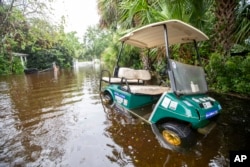Tropical Storm Debby is expected to make landfall for a second time in South Carolina late Wednesday or early Thursday, having taken the lives of six people earlier in the week.
The storm hit the southeast United States on Monday, initially making landfall in Florida as a Category 1 Hurricane. It has since moved into the western Atlantic but continues to cause concern as it is predicted to regain some strength before hitting South Carolina again.
Florida Governor Ron DeSantis issued an executive order on August 2, prior to the storm making landfall, and declared a state of emergency in 61 counties. The order gave state officials the ability to distribute resources to areas that were expected to be impacted by the storm.
White House press secretary Karine Jean-Pierre outlined the federal government’s response to the story at a press briefing Tuesday.
“The Biden-Harris administration has been in close touch with officials from affected states and FEMA has deployed staff to the region to support as needed,” she said.
Federal support such as FEMA’s Urban Search and Rescue Teams, the U.S. Coast Guard, the U.S. Army Corps of Engineers and more have been deployed and will provide support to the impacted areas as needed.
Jean-Pierre continued, “The president has approved emergency declaration requests from the governors of Florida, South Carolina and Georgia, which will unlock additional federal resources.”
The White House is also recommending that those who remain in Tropical Storm Debby’s path to stay alert and visit ready.gov for safety tips.
A series of disasters
Tropical Storm Debby comes less than a month after reports of power outages that affected millions in Texas, resulting in seven reported deaths due to heat exposure. The power issues were part of the aftermath of Hurricane Beryl, which first hit the state on July 8. The storm also comes just weeks after Illinois saw 25 tornadoes hit the Chicago area in the span of two days.
As the summer’s climate disasters continue, affected areas will seek the support of the federal government and Biden administration to help offset damages and minimize the risk of casualties. The administration has made climate change a key issue since President Joe Biden took office in 2021.
“Climate-fueled disasters are impacting communities nationwide — and it’s costing the U.S. billions every year,” White House spokesperson Jeremy M. Edwards told VOA on Wednesday.
“That’s why President Biden is leading the most ambitious climate agenda in history, including securing the Inflation Reduction Act, the largest-ever climate investment, which provides billions to help communities build resilience to these increasingly frequent and extreme weather events.”
The Inflation Reduction Act was signed into law in 2022 and aims to combat air pollution and climate change. The Biden administration faced climate-based criticism in 2023 after it approved the Willow Project, which allows for massive oil drilling in Alaska.
Some $92.9 billion in damages from natural disasters were recorded in 2023, reaching a record high of 28 such events that cost more than $1 billion. As of July, the National Centers for Environmental Information confirmed 15 disasters that have cost the U.S. more than $1 billion so far in 2024.
Source: voanews.com




